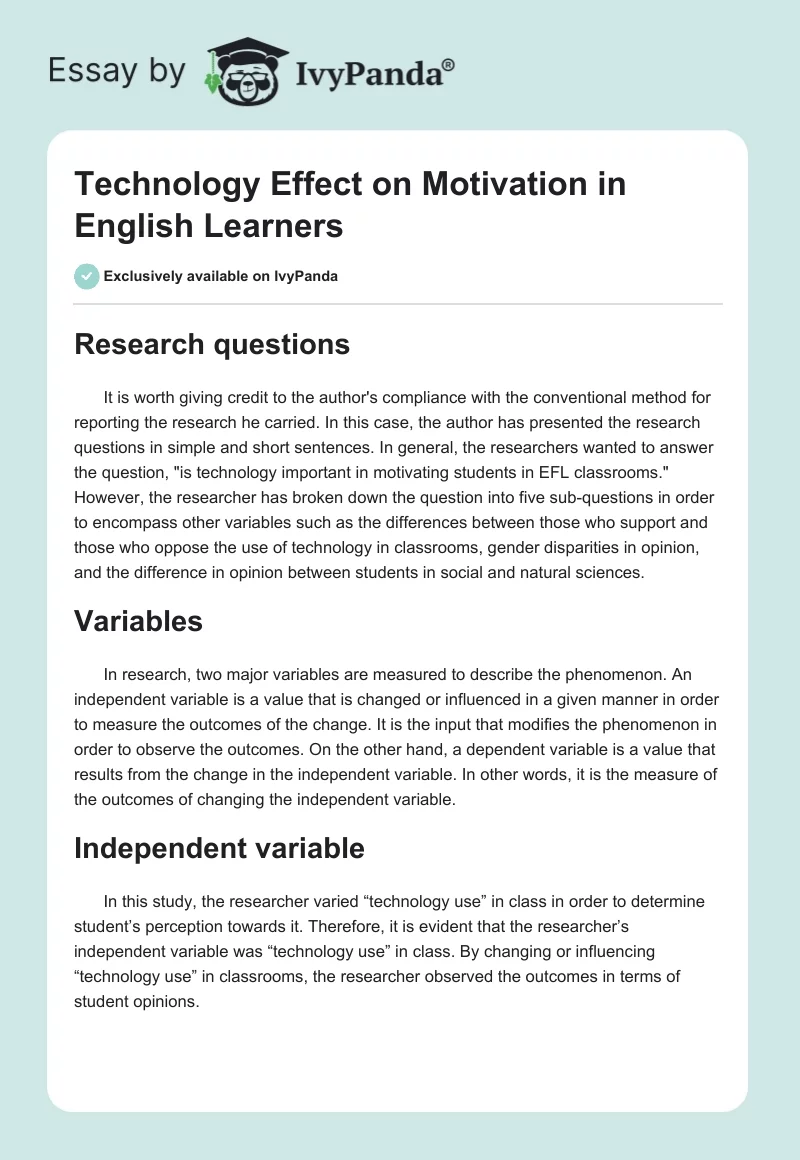Research questions
It is worth giving credit to the author’s compliance with the conventional method for reporting the research he carried. In this case, the author has presented the research questions in simple and short sentences. In general, the researchers wanted to answer the question, “is technology important in motivating students in EFL classrooms.” However, the researcher has broken down the question into five sub-questions in order to encompass other variables such as the differences between those who support and those who oppose the use of technology in classrooms, gender disparities in opinion, and the difference in opinion between students in social and natural sciences.
Variables
In research, two major variables are measured to describe the phenomenon. An independent variable is a value that is changed or influenced in a given manner in order to measure the outcomes of the change. It is the input that modifies the phenomenon in order to observe the outcomes. On the other hand, a dependent variable is a value that results from the change in the independent variable. In other words, it is the measure of the outcomes of changing the independent variable.
Independent variable
In this study, the researcher varied “technology use” in class in order to determine student’s perception towards it. Therefore, it is evident that the researcher’s independent variable was “technology use” in class. By changing or influencing “technology use” in classrooms, the researcher observed the outcomes in terms of student opinions.
Dependent variable
The researcher measured student motivation through their perceptions towards the use of technology in EFL classrooms. Student motivation was universal regardless of the type of technology used. As such, motivation in the form of perception is the dependent variable.
Participants and research setting
The participants were all students at the university. There were 350 students used as the study sample. Internal variables include gender and department (social science and natural science). Therefore, the degree of homogeneity is relatively high because the students belong to the same population (Binur, 2009). Secondly, the number used (350) adequately represents the entire population at the university, given that the university has a homogenous population. This number is commendable.
Research methods
The study utilized statistical analysis of the participants’ responses. Therefore, the study is a quantitative research that attempts to describe the phenomenon based on the statistical inferences drawn from the participant’s perceptions. Secondly, the study used questionnaires as the data collection technique. In theory, an important advantage of using this method is that it is simple and easy to operate. Secondly, it is easy to draw information from the participants because they are given privacy. The participants are likely to give honest responses. However, it is prone to errors because the participants might influence each other in giving dishonest responses.
Evaluation of the Statistical test
The researcher used statistical analysis of the data based on a Likert scale to determine the perception of the participants. In this case, the scale is effective in determining the respondent’s feeling or perception towards the issue at hand. However, it is not effective in cases where the respondents want to express their perceptions.
Secondly, SPSS was used for data analysis. This is a strong tool for data analysis because it is computer software that enhances statistical analysis. It provides the researcher with an easy way of performing a wide range of analyses, including regression and variance.
Evaluation of Results and discussion
Using the SPSS statistical tool, the researcher analyzed the responses for every question. Credit should be given for the researcher’s ability to present the results in tabulated forms, which are copied from the SPSS results. In addition, by setting a chi-square and a standard significant level of.05, the researcher built efficiency and consistency of the results (Binur, 2009). In addition, it is an important technique for determining and expressing relationships between variables.
It is also worth noting that the responses for every question were discussed against the results of the corresponding SPSS results. The researcher has shown evidence of consistency and quality arrangement of the discussion. Thus, inferences are made at every question.
Value, strength, and limitations
Statistical analysis has allowed the researcher to draw inferences from the participants. This is important because their perceptions are used to describe the phenomenon. In addition, SPSS is a strong tool in providing quality and concise information.
It is also worth credit because the study has used a small sample to describe the phenomenon that affects larger populations. The method is also easy to perform.
However, it is prone to errors. Students are likely to influence each other in providing responses. The researcher must have obtained a good number of dishonest responses.
Further research
The researcher found that technology enhances motivation in EFL classrooms. This reveals the need for further studies in different classrooms as well as different institutions.
Application of the study
I find the study method important in determining how technology can influence outcomes in education. Using the same method, the study can now be used to determine the impact of technology on educational outcomes since it has already been shown to be effective in motivating students.
Reference
Binur, M. (2009). Effect of technology on motivation in EFL classrooms. Turkish Online Journal of distance education-TOJDE, 10(4), 136-158.


